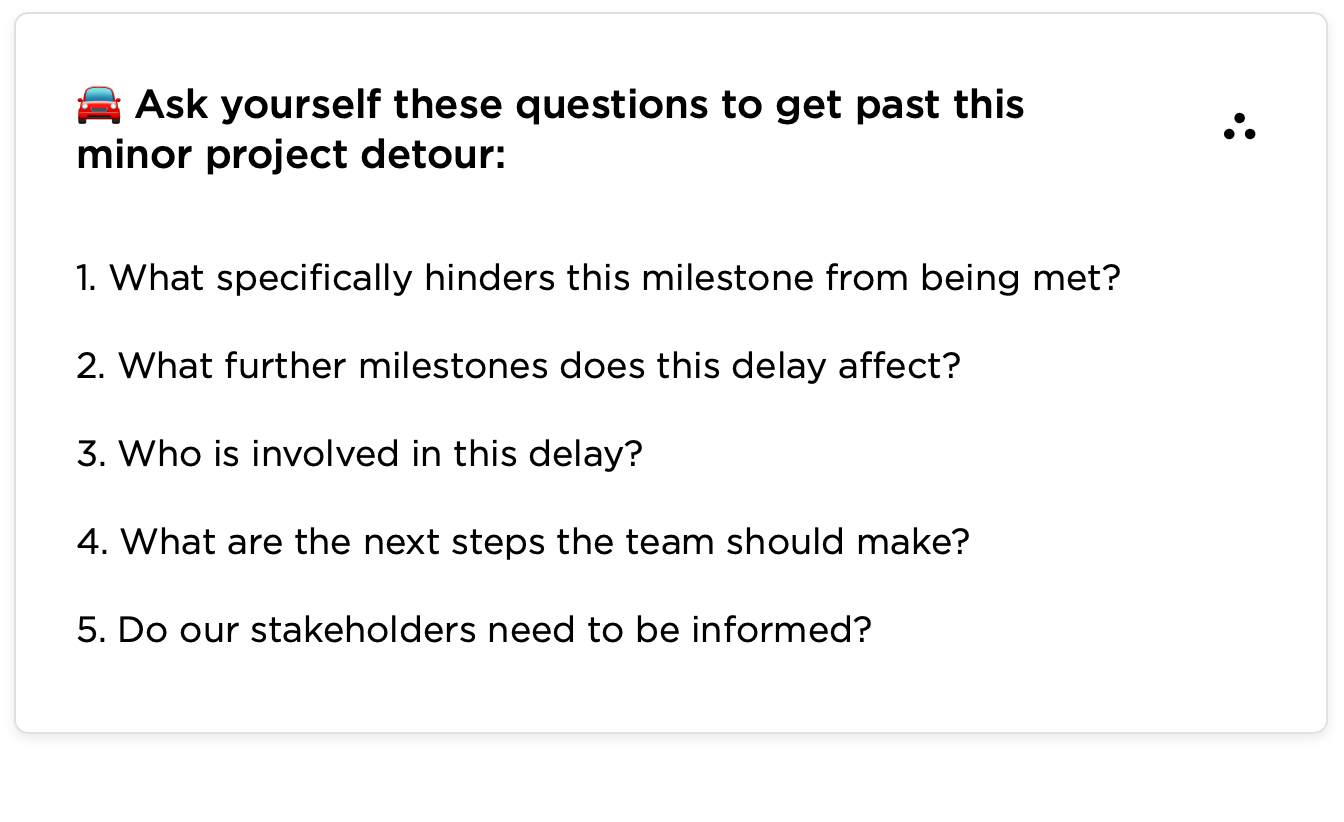Everything You Need to Know About Milestone Planning

Your guide to milestone planning
It’s no secret that project management is vital to a successful project. In fact, organizations who prioritize project management culture report that 71% of their projects meet their initial goals and business intents.
But we know that keeping track of large projects can be a real rocky road, especially when they have a lengthy lead time. That’s why we are excited to talk you through milestone planning, a tool to help you stay organized throughout your project development.
Highway 101: Milestone Planning Basics
Milestone planning is a specific way of organizing your project. It targets outcomes, progress, external dates, and customer collaboration to achieve project goals. In other words, milestones identify a checkpoint along the timeline of your project.
A typical project milestone might look something like this:
Goal: Create a new website design
Project kick-off - on September 15th
Complete requirement review - by October 3rd
Stage 1 approval - on October 24th
Stage 1 completed - on November 21st
Finalize documents - by December 15th
Project handover - on January 7th
Two of the most popular methods for project scheduling are the Critical Path Method (CPM) and the Program Evaluation and Review Technique (PERT).
1. Critical Path Method
CPM is a simple quantitative tool that assists in analyzing, organizing, and executing large-scale projects. It determines two things; which tasks make up the critical milestones of your project, and secondly, the least amount of time you’ll need to complete a project.
What sets this method apart from other variations of milestone planning, is that the set tasks must be started and completed independently from each other. For example, when you are building a house from the ground up, you have to frame the walls before you build the roof.
This way of project planning gives you the technique to find the most realistic project deadline, a very important detail for your team and client.
2. Program Evaluation and Review Technique
PERT is used in smaller scale projects to maximize the use of team resources and better estimate delivery times. The project timeline is represented on a flowchart that shows different nodes to symbolize events and milestones. This method uses dimensions of time to indicate the starting and ending points of the planning process, such as optimistic time, pessimistic time, most likely time, and expected time.
Woah, who would’ve thought that milestone planning could get so technical? Don’t stress, we’ll break it all down for you.
Your Milestone Planning Roadmap
You are taking on a huge task. It’s a multi-department assignment with a large group of team members. You already know the basics, the goal and objectives, but what now? How do you approach this monster-truck of a project?
Pitstop 1: Setting Milestones
Depending on the length of your project, you might have three milestones or you might have 30 milestones! Either way, you should start out the same way, by mapping out everything that needs to be done to reach your project goal.
💡Goal vs. Milestone? Remember that a goal is what you want to achieve and a milestone is how you achieved it. If you’re on a road trip, your goal is the destination and your milestones are the pitstops you made along the way.
You should talk to everyone on your team, the experts, the leaders, and the clients to get all the project details. They will tell you everything you need, such as necessary resources, estimated duration of certain tasks, and required tools to help you in your milestone planner.
But we understand that finding the most critical milestones can be difficult, even with the help of your team! Take into consideration “SMART” milestones, a way to help you recognize the most important events to achieve your project goal.
SMART stands for Specific, Measurable, Achievable, Realistic, and Timely objectives. Here’s the gist:

By setting milestones that are SMART, you can break down sections of your project so that they are manageable and straightforward to track. And of course, you also encourage a clear and mutual understanding of project expectations and performance levels with your team.
Pitstop 2: Using Milestones
So now that you’ve found your milestones, it’s time to put your project into motion. As your team begins to execute work, you have to assess if your milestones are met, sorta-met, or missed, and then re-evaluate your plan to serve your end goal.
Say for instance you’re working on another construction project. You have all your milestones in place, but you still haven’t received your city permit, meaning your crew can’t start building. Since you can see how that missing permit affects your plan, you are able to reevaluate your project priorities so your team can continue moving forward.

💡 One important thing to remember is that you should keep your client informed throughout your project development. This reduces miscommunication, maintains positive impressions, and acts as a way to receive feedback on the project!
Setting and using milestones is extremely helpful in your project development. Setting milestones establishes your project priorities, especially those certain tasks that need a little extra attention or require more time to finish. And by using milestones, you make sure your project is always advancing so you can keep everyone in the loop.
Hit the Breaks! Common Mistakes
While creating your milestone plan, be aware of these three common mistakes.
1. Too Many or Not Enough Milestones
As we mentioned before, the amount of milestones is specific to your project. But it’s okay to be picky with which milestones you include. Milestones are designed to emphasize important points within your timeline, but when you have too many, your timeline is crowded and confusing. This makes it harder for your team to find their specific role and responsibilities.
Nevertheless, the opposite could also be a problem, not enough milestones. Your minimalist approach could result in a project that deviates off its original trajectory. Your teammates or clients might be unsure where they fall on the project timeline, or what their next steps are.
2. Vague Milestones
In general, milestones don’t incorporate many details. But sometimes milestones need to be associated with supporting information, such as meeting minutes, reports, client feedback etc. The best way to overcome this hurdle is to find a tool that incorporates all your work in a central place, like at Collato!
3. Poor Communication
Nothing kills a good project like poor communication. Once your milestones are established, they should be shared with the appropriate team members and clients. By sharing your milestone plan, you skip all those tedious catch-up phone calls, confusion emails, etc. Save yourself some time and communicate with everyone from the beginning!
Take it For a Spin
Now that you’re an expert on milestone planner, from the very basics to the common errors, you’re ready to try it out yourself! But if you don’t want to, let Collato steer you in the right direction. Check out how you can place all your project activities and milestones on a central timeline to collaborate with your team and clients. The best way to accelerate your project to success!
Collato for Milestone Planning
Integrating office knowledge with Collato into milestone planning can revolutionize the way you organize and execute your projects. With Collato's instant information retrieval and Slack integration, you can easily access critical company information and promote effective communication within your team.
Milestones act as checkpoints along the project timeline, allowing you to monitor progress, track external deadlines, and collaborate with your clients. As your team works, Collato enables your team to work together and share and recall information instantly, helping you track milestone achievements, identify potential roadblocks, and adjust your plan accordingly.
Collato's Slack Assistant also empowers your team to stay informed. Our new Slack integration brings you the scattered information you need, all within the Slack environment. Open communication with your team ensures everyone is informed and aligned. With Collato's knowledge map and Slack integration, you can streamline your milestone planning.



